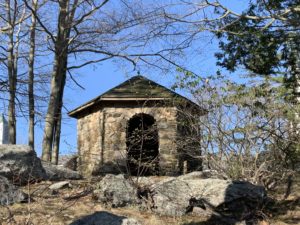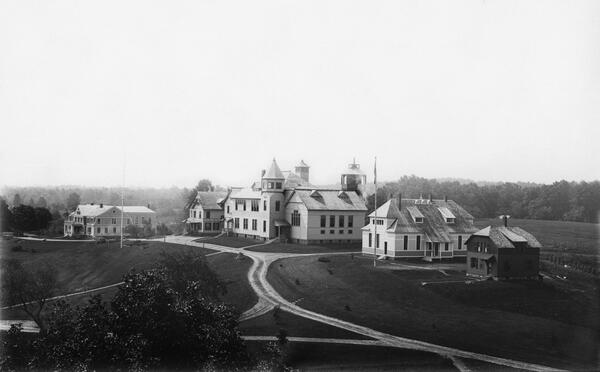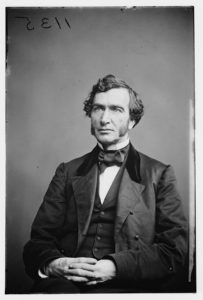By Michael Rodriguez
The University of Connecticut was not always the state’s land-grant university. For 30 years, from 1863 to 1893, Yale University held that crown. After Connecticut’s farmers became frustrated with Yale’s academics and lofty admissions standards, the General Assembly voted to transfer land-grant status and revenue to Storrs Agricultural School. The Yale-Storrs controversy set this rustic little school on its path to becoming UConn.
Enacted by Congress in 1862 and expanded in 1890, the Morrill Land-Grant Act all but revolutionized higher education in the United States. It awarded federal land and money to states to establish colleges or endow existing institutions to teach the agricultural and mechanic arts. Congress aimed to expand access to higher education, albeit at the cost of indigenous peoples on whose ancestral lands the universities sat or from which they profited. Connecticut received 180,000 acres in the Midwest and immediately sold this land for $135,000. While Massachusetts and most other states used land-grant funds to support public colleges, Connecticut struck a deal with Yale University instead.
Yale Becomes Connecticut’s Land-Grant University
In 1863, Yale agreed to teach applied sciences and offer full-ride scholarships to up to 60 Connecticut residents a year to study at Yale’s Sheffield Scientific School. In return, Yale was to receive all of Connecticut’s land-grant revenue. Over the next 30 years, Yale ramped up its agricultural sciences programs, attracted top researchers and students, and launched the nation’s first agricultural experiment station. Even before the passage of the Morrill Act, Scientific American observed that Yale had been “stepping out from the mists of antiquity and the graves of dead languages and ‘taking up the shovel and the hoe.’” However, Yale was not hoeing fast enough to suit Connecticut’s farmers.
The Connecticut State Grange, a branch of the National Grange of the Order of Patrons of Husbandry, was a statewide association of farmers and a powerful pro-farming lobby. In 1886, Worthy Master J. H. Hale spoke out. He blasted Yale’s strict admissions policy, which required proficiency in Latin and trigonometry. “How many farmers’ boys have the time to fit themselves for such an examination as is here required?” demanded Hale. He then answered his own question. In 24 years, Yale had graduated only seven students from its agricultural program—and at the staggering price tag of $25,700 per student, or $725,000 in today’s dollars. The Grange demanded practical education and more of it.
Storrs Agricultural School (now the University of Connecticut) had been founded in 1881 to teach practical farming. The rustic little school gained a much-needed boost when the General Assembly, facing pressure from the Grange, voted to split the latest infusion of federal dollars (this time from the Hatch Act of 1887) between Yale and Storrs. Powerful state representative William E. Simonds, a Grange ally, called for a land-grant institution that was more than a mere “side show to a classical institution.” The Storrs Agricultural School fit the bill. When Congress expanded the Morrill Act in 1890, offering even more federal land-grant funding to the states, pressure mounted on the legislature to act.
Connecticut Legislates, Yale Litigates

Little Stone House, gift of the Connecticut Grange to the Connecticut State College in 1937. (Credit: Michael Rodriguez, 2021)
On March 31, 1893, the General Assembly made the Storrs Agricultural School the sole beneficiary of Morrill and Hatch Act funds, upgrading the institution to Storrs Agricultural College. Public Act 67 passed resoundingly by a margin of 4-1 in the House and a vote of 18-2 in the Senate. The bill passed 12 years to the day since the school’s founding.
Yale swiftly sued, claiming that the state had breached its contract with Yale by yanking land-grant status—a loss of prestige and $32,000 per year to the school. The lawsuit dragged out in U.S. circuit court, while Yale and Storrs supporters debated the question in the newspapers. The case went to arbitration, where Yale was awarded $154,604 in damages in 1896. The state paid up, Yale permanently lost its land-grant status, and Storrs became Connecticut’s land-grant institution, which UConn remains today.
Forty years later, in 1937, the Connecticut Grange dedicated the Little Stone House at Storrs. It contained a stone from every town in the state and every state in the nation. This monument signified the abiding camaraderie between the Grange and UConn.
Michael Rodriguez is Library Collections Strategist at the University of Connecticut and has contributed more than 70 articles on Connecticut history to Wikipedia.









